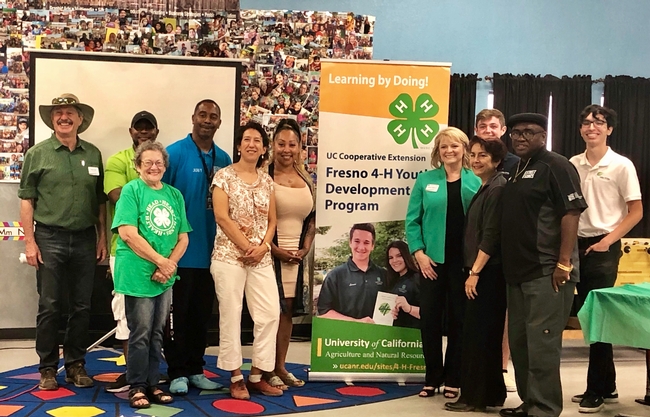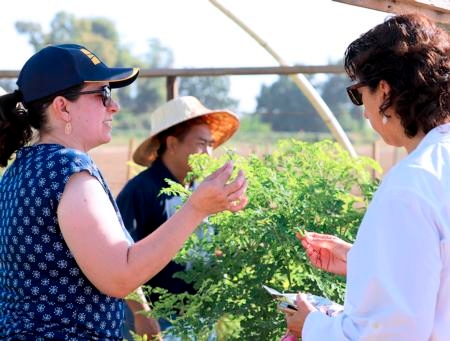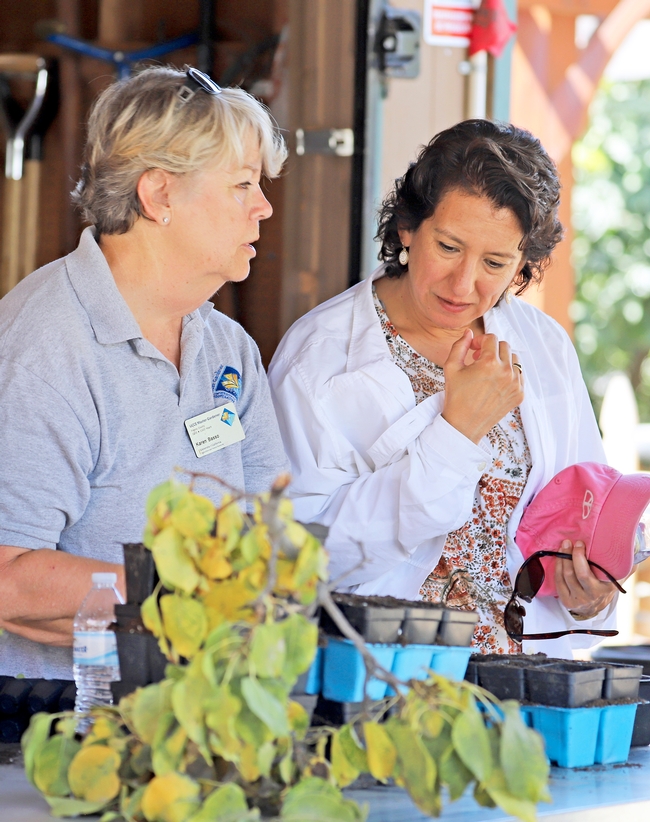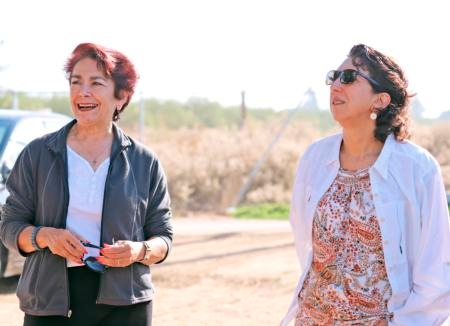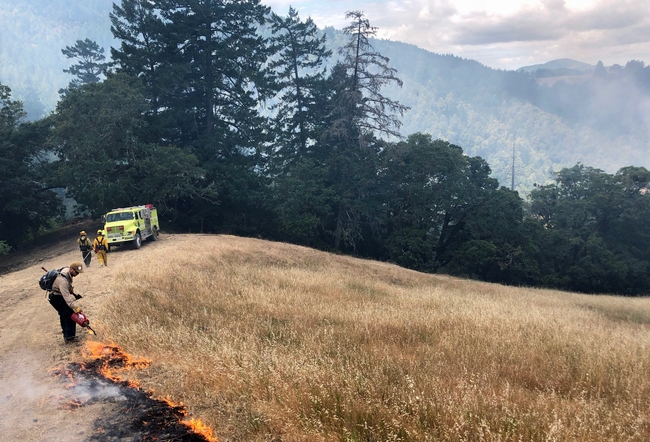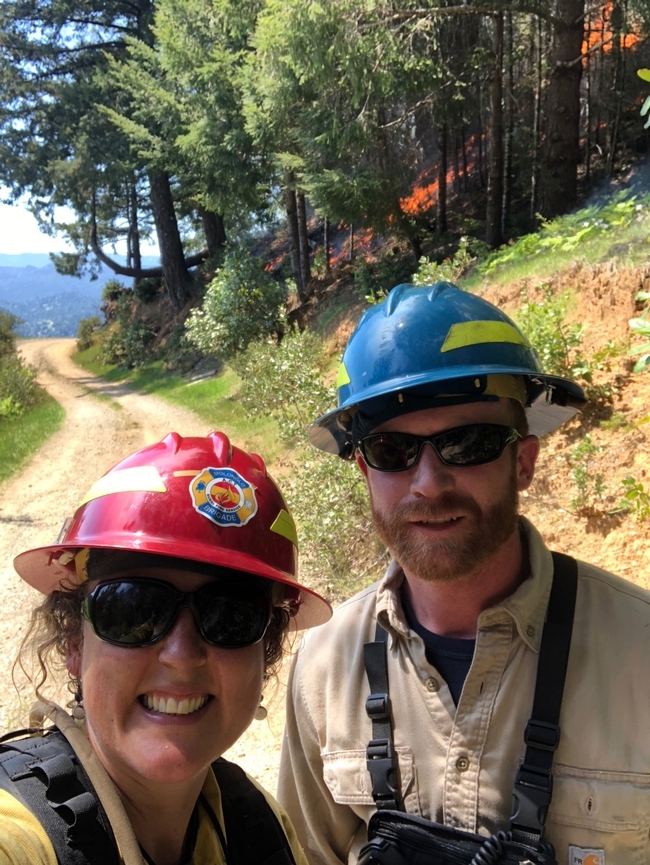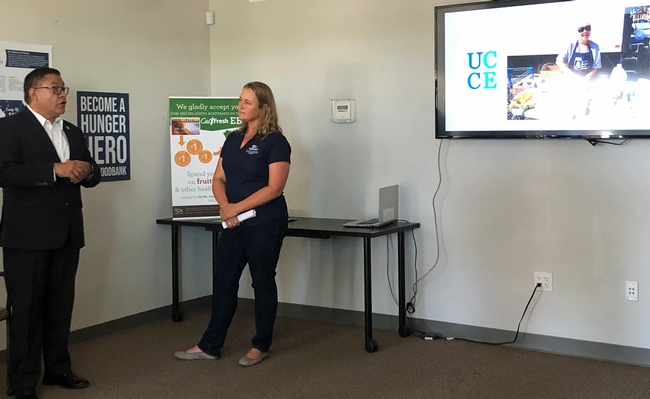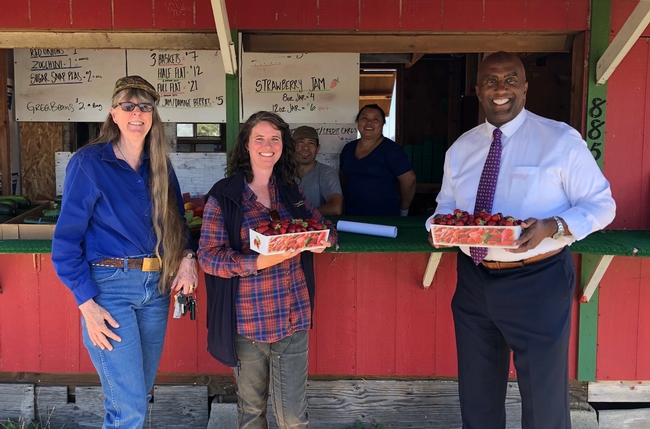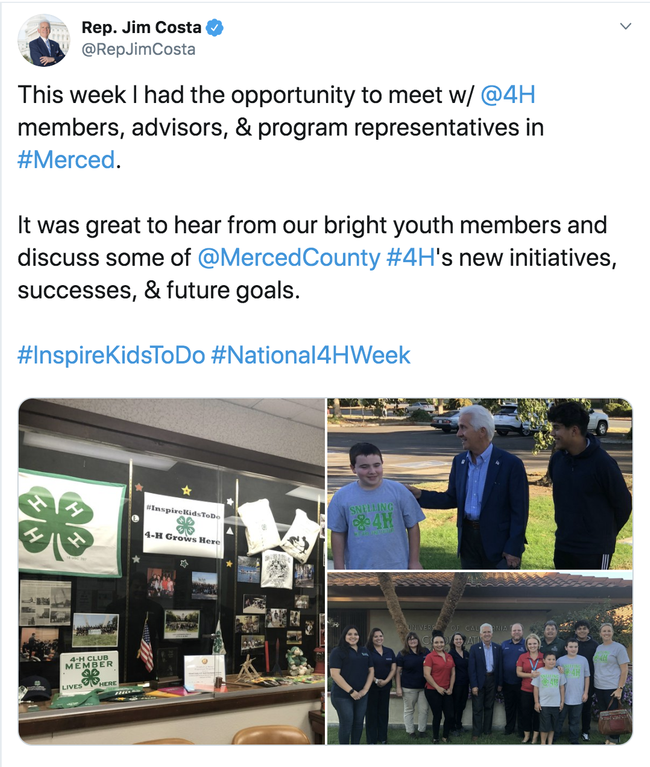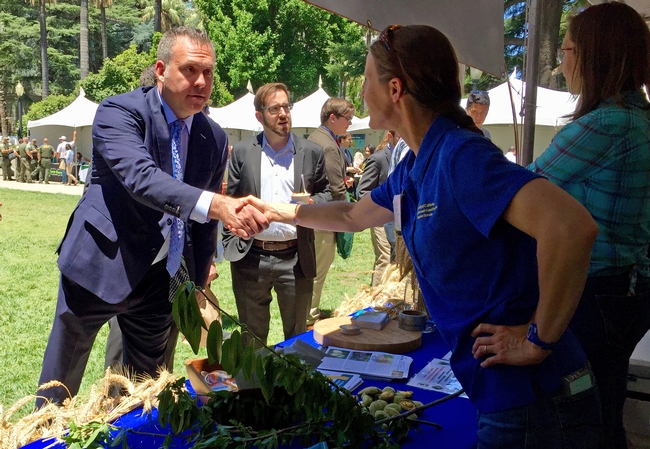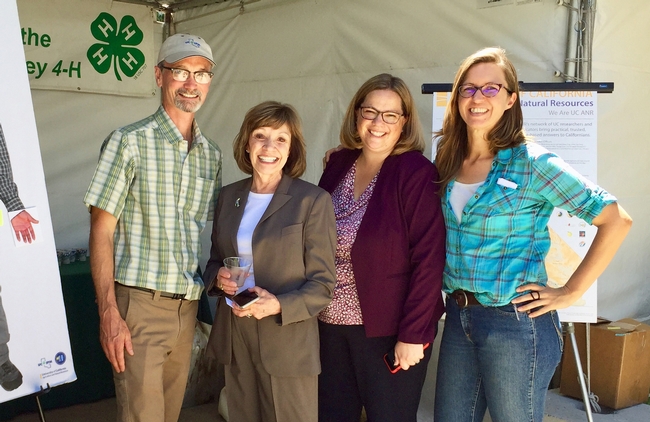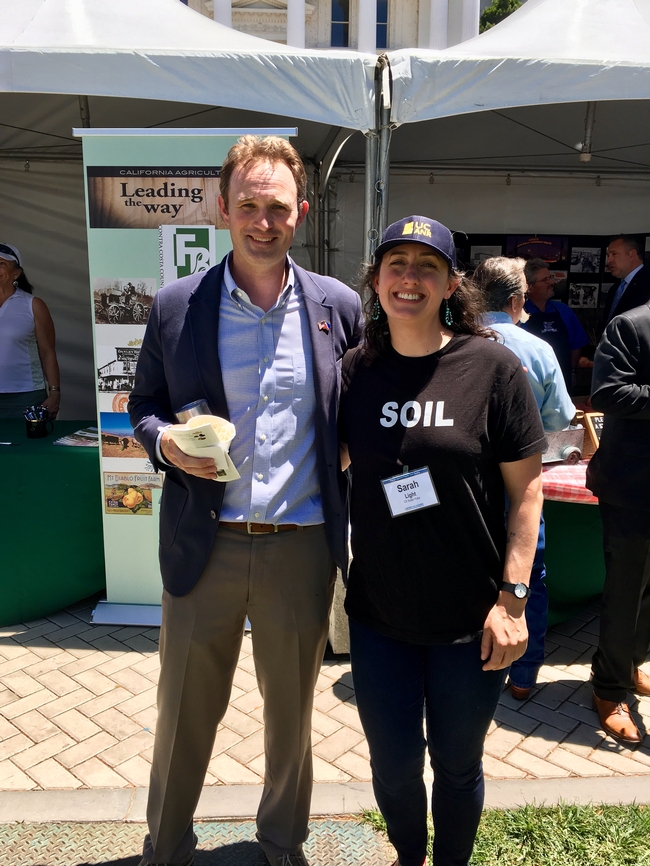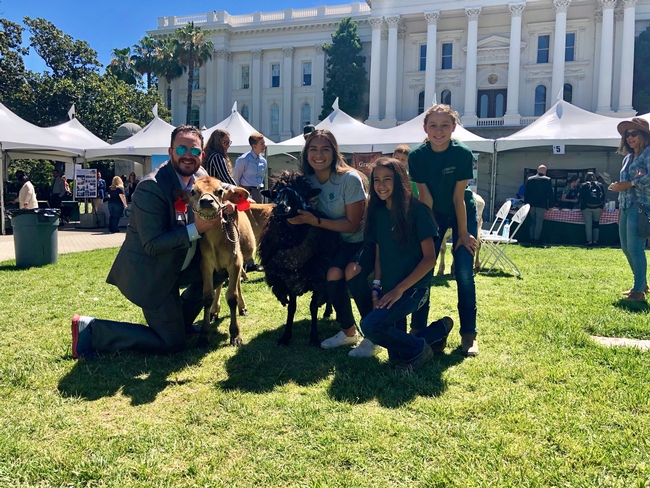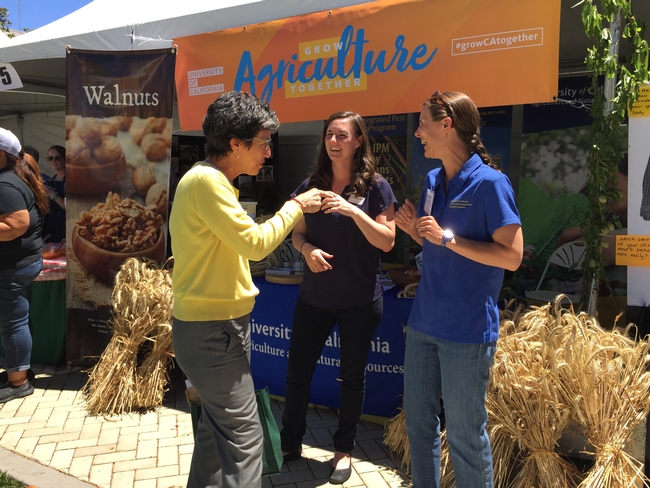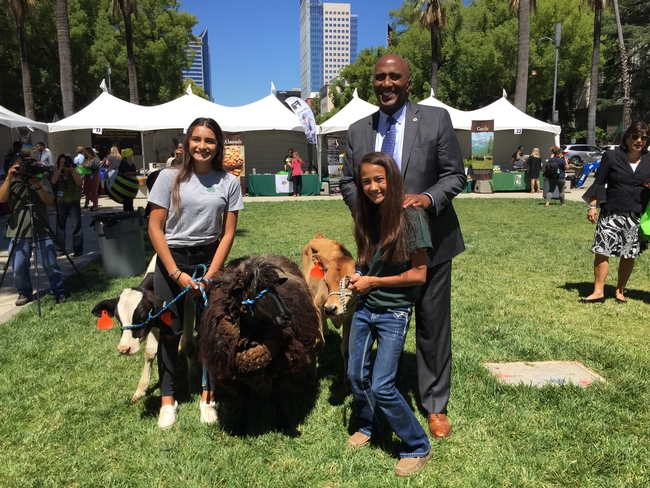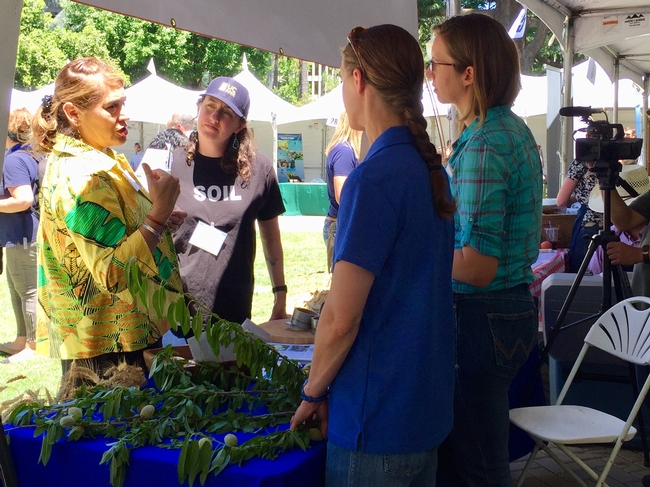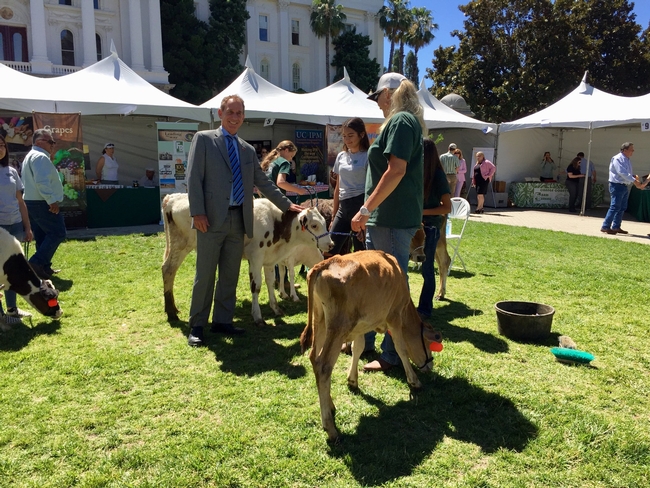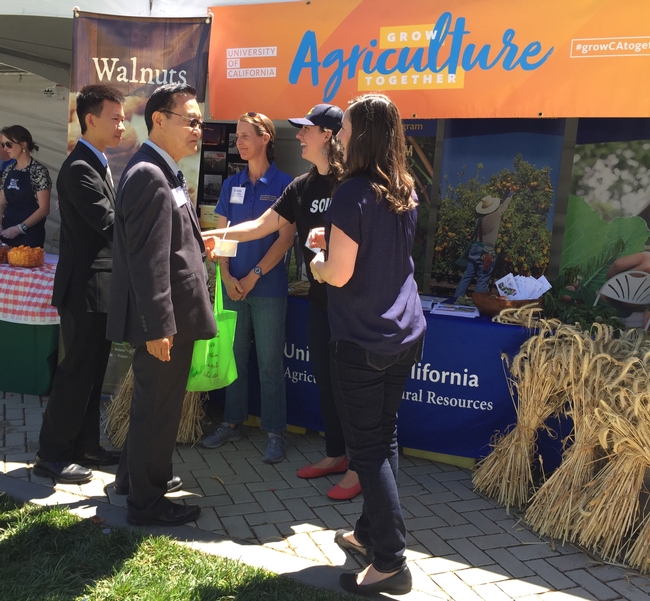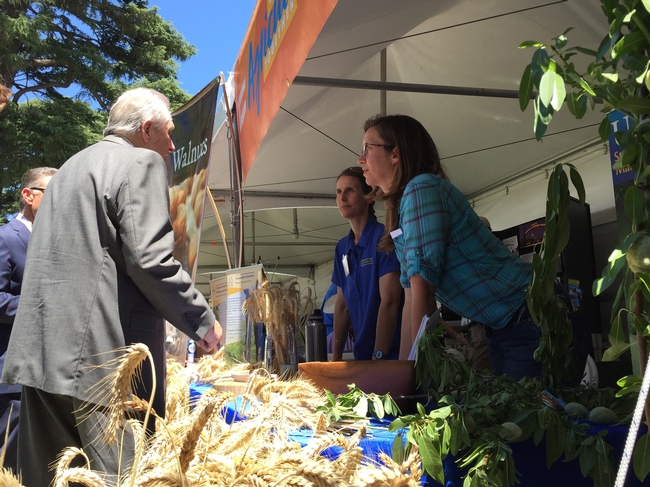Posts Tagged: advocacy
Regent Estolano, Senator Caballero tour UCCE Fresno
“UC ANR touches the lives of thousands of people in rural communities and urban centers alike,” said state Senator Anna Caballero, after meeting UC Cooperative Extension staff and stakeholders in Fresno County. Caballero joined UC Regent Cecilia Estolano for a tour Sept. 25 to see results of ANR's work with small-scale farmers, 4-H youth and UC Master Gardener volunteers.
“On my tour, I saw how ANR is a valuable partner across generations and communities for Californians who grow our food, and green our neighborhoods,” Estolano said. “From urban 4-H chapters to Master Gardeners to culturally connected crop advisors and nutritional instructors, ANR is keeping California on the leading edge of agriculture, health and healing.”
Joined by Vice Provost Mark Bell, UCCE Fresno County Director Karmjot Randhawa, and Anne Megaro, government and community relations director, Caballero and Estolano began the tour with a visit to the Thao family farm, where they learned about specialty crops – such as jujubes and moringa – grown in the area by Southeast Asian farmers. UCCE farm advisor Ruth Dahlquist-Willard described growing and marketing moringa and her work to help bring resources to disadvantaged farmers to help improve their prosperity. Michael Yang, UCCE Hmong agricultural assistant, talked about delivering UCCE information to farmers in Hmong via his radio program.
Next, they visited Street Saints, a program of the Fresno Economic Opportunities Commission, and learned how they created an afterschool program to keep low-resource youth in Southwest Fresno safe. The Street Saints, who partnered with 4-H, described for the senator and regent how they promote healthy choices to deter young people from engaging in gang activity in their urban setting. Using 4-H's evidence-based curricula, Street Saints offers a safe place for youth after school where participating youth develop employment skills through 4-H activities such as sewing classes, STEM Teen Teachers, “Mindful Me” to improve physical and emotional health, and working in a community garden.
“It was exciting to see the interaction between the senator and regent with the UCCE stakeholders,” Randhawa said. “Both seemed really engaged in the work and asked questions. It's vital for them to see how we engage with the community and how the community amplifies the research and support we provide. They met small farmers and 4-H members who have built businesses based on their work with 4-H and Cooperative Extension. They met with Master Gardeners. It was fantastic for them to experience, rather than be told, how we deliver ANR's mission.”
Megaro got the impression Caballero and Estolano enjoyed meeting some of the Californians who have bettered their lives by participating in ANR programs.
“I think they both knew us mostly for our rural agricultural work, but this tour really showed them how we're active and present in urban communities to effect change and how we partner with community-based organizations to further our reach.” Megaro said. “We also talked about how the sites we visited were just one example of the programs and services we provide throughout the state, and how we are looking to increase resources so we can build out our programs to serve more people.”
At UCCE’s suggestion, Humboldt waives air-quality fees for public benefit burning
“I thought you all might enjoy this bit of good news from Humboldt County. Yesterday reminded me of the important role we at UCCE can play in these types of local issues,” wrote Lenya Quinn-Davidson, UCCE area fire advisor in Humboldt County.
Concerned about habitat loss and fuel buildup on private lands in Humboldt County, Quinn-Davidson and Jeff Stackhouse, UCCE livestock and natural resources advisor, recently formed a Prescribed Burn Association.
Thanks to Senate Bill 1260, which was signed into law last year, air districts are receiving grants from the California Air Resources Board to support local prescribed fire programs.
Stackhouse and Quinn-Davidson attended the North Coast Unified Air Quality Management District Board meeting Sept. 18 in Weaverville to suggest their district subsidize the air quality permit fees for prescribed burners.
“Our district has decided to use some of these grant funds to subsidize air quality permit fees for prescribed burners in the district. This is welcome news to those of us with the PBA who have been working for the last year to alleviate air quality permit fees, which can be $250 to $1250 for bigger projects. For our PBA burns, air quality permit fees are one of our biggest project costs, and now those fees will be waived.”
The air board's original plan was to subsidize projects with a focus on wildfire risk reduction. At the meeting, she and Stackhouse encouraged them to broaden the scope and include all projects that have a public benefit, including burns focused on habitat restoration, range improvement, forest improvement, cultural resources, etc., in addition to fuels reduction.
“We suggested that they tie the subsidy program to Public Resources Code 4475, which was amended through SB1260 to include an expanded definition of ‘public benefit burning.' They accepted our suggestion and amended the rule to reflect this broader suite of project types, which covers most of the great burning we're all doing in the North Coast: oak woodland restoration, medusahead/starthistle/blackberry control, coyote brush/coastal rangeland/prairie burning, understory fuels reduction, etc. With this cost relieved, we can start thinking about planning more projects and bigger projects! Yesterday, a 300-acre burn would have cost $1,250 (permit) + $65 (smoke management plan). As of today, those costs will be $0.”
The district's proposal also recommended excluding federal agencies and timber companies from the subsidy program, but Quinn-Davidson and Stackhouse asserted that any entity doing work that benefits the public should have equal access to the subsidy. In response, the Board voted to expand the program to include federal agencies and timber companies.
“Based on what air district staff said at the meeting, it sounded like this would save landowners about $14,000 to $18,000 per year in fees district-wide. I think it'll be even more than that in the coming years, with all the interest we have in prescribed fire,” Quinn-Davidson said.
“We're still working with the district to think about longer term solutions to their fee structure, but in the meantime, this is a fabulous step in the right direction!” Quinn-Davidson said.
Congressman Carbajal tours UCCE projects in SLO and Santa Barbara
The UCCE team in San Luis Obispo and Santa Barbara counties met with Congressman Salud Carbajal and his team twice in the past few weeks. On Aug. 20, Jeremy Tittle, the congressman's chief of staff, and Erin Sandler, the congressman's scheduler, visited. The congressional staff met with UCCE advisors, office manager, and director to learn more about UCCE research and programming.
UCCE advisor Ben Faber led a tour of research and education collaborations at Cal Poly, sharing research occurring on pomegranates, blueberries and other crops. In the afternoon, UCCE advisor Mark Battany led a tour at Wolff Vineyard, discussing research on how climate conditions relate to frost and water management.
The following week, Katherine Soule, UCCE director, met with Congressman Carbajal and project collaborators to discuss the outcomes and success of a USDA Community Food Project grant. On Sept. 5, the congressman visited with the project partners at the Food Bank Coalition of San Luis Obispo County.
Community partners described their contributions to the project, including UCCE's efforts to reduce food waste, increase awareness of local food systems, and maximize limited food resources through the UC Master Food Preserver Program. For this project, UC Master Food Preservers teach low-cost, safe, home food preservation methods to clientele receiving food at food bank distribution sites. During this meeting, the partners also discussed the San Luis Obispo County CalFresh Alliance's objective to increase CalFresh participation in the county.
San Luis Obispo County currently has one of the lowest CalFresh participation rates in the state so the partners have been working together to identify and address barriers to participation. Carbajal shared his concerns about the low rates of participation and his commitment to working to address food insecurity in the region.
These successful visits led Carbajal's team to schedule a meeting with 4-H youth, families and volunteers in San Luis Obispo and Santa Barbara counties in the next few months.
Advocacy is about building relationships
How do you achieve this? Communicate with all audiences throughout the year, not just during times of need. This helps form relationships as well as a deeper understanding of what it is that you do and how your work impacts the local community. This helps build a lasting relationship and a desire to support your research, programming, and services.
Many of our stakeholders know us through one program. By educating them about how our programs and academics work together – such as Master Gardener volunteers extending UC IPM information to the public or scientists with complementary expertise working together to address issues – people gain an appreciation for the value of UC ANR as a whole, not just individual programs. It's an impressive value proposition and it makes a difference in the lives of all Californians.
How should you educate elected officials?
As university employees, we may indicate our needs and ask for support with many audiences (e.g. funding organizations, boards of supervisors, donors, etc.) but we must take into consideration other factors when talking to elected state or federal officials or their staff members.
We can, and should, educate and inform elected state and federal officials and their staff of the work UC ANR does in their districts. However, we cannot take positions on bills or ask for budgetary support without the expressed consent from the UC Office of the President. Only the regents, who have delegated authority to President Napolitano, can determine UC's official position on legislative issues.
So, what can you do if you can't ask for money?
Share the impact of your work. Be specific! Tell a story and use UC ANR's public value statements to guide you. Sometimes a personal story about an individual who benefited from your work is easier to remember, and more moving, than total program impact to an entire community. For example, talk about your work solving a problem with a specific farmer and how it improved their bottom line, share a 4-H youth project, talk about working with a specific community partner and describe how you worked together to achieve a shared goal. Did you promote economic prosperity, develop a qualified workforce, or promote healthy people and communities? Did your partners save money? Did more 4-H youth go to college? Did participants lead healthier lives?
If we fine-tune the way we message our story and impacts, we can ensure that UC ANR will become widely known as the face of UC in communities throughout California.
For more information, see my one-pager at http://ucanr.edu/sites/Professional_Development/files/293044.pdf. Feel free to contact me at (530) 750-1218 or ammegaro@ucanr.edu.
Farm Bureau celebrates centennial at Capitol
University of California Agriculture and Natural Resources joined in the California Farm Bureau Federation's Centennial Celebration at the State Capitol on June 26.
State legislators visited booths where county farm bureaus displayed products from local growers and ranchers and discussed the benefits of agriculture in their county.
UC ANR was represented by Jim Farrar, UC IPM director; Michelle Leinfelder-Miles, UCCE Delta crops advisor for San Joaquin, Contra Costa, Sacramento, Solano and Yolo counties; Sarah Light, UCCE agronomy advisor for Sutter-Yuba and Colusa counties and Katherine Jarvis-Shean, UCCE orchard systems advisor for Sacramento, Solano and Yolo counties. They answered questions about pest management and crop production and discussed their research and outreach.
4-H volunteer Julie Farnham and Nicole Jansen and members of the Esparto/Capay Valley 4-H Club brought a small petting zoo consisting of three dairy calves and two exotic sheep and talked with legislators about the benefits of participating in 4-H.
“The California Farm Bureau Federation's Centennial at the Capitol was a great opportunity to talk with legislators about how UC is present in their districts and helping their constituents,” said Anne Megaro, director of government and community relations, who coordinated ANR's participation in the event.
UC Cooperative Extension has partnered with the Farm Bureau for more than a century. As UC Cooperative Extension was being organized in 1913, UC leaders required each county government that wanted to participate in the partnership to allocate funding to help support extension work in that community. It was also required that a group of farmers in participating counties organize into a “farm bureau” to help guide the UCCE farm advisor on the local agriculture issues. These grassroots groups later evolved into the California Farm Bureau Federation.

